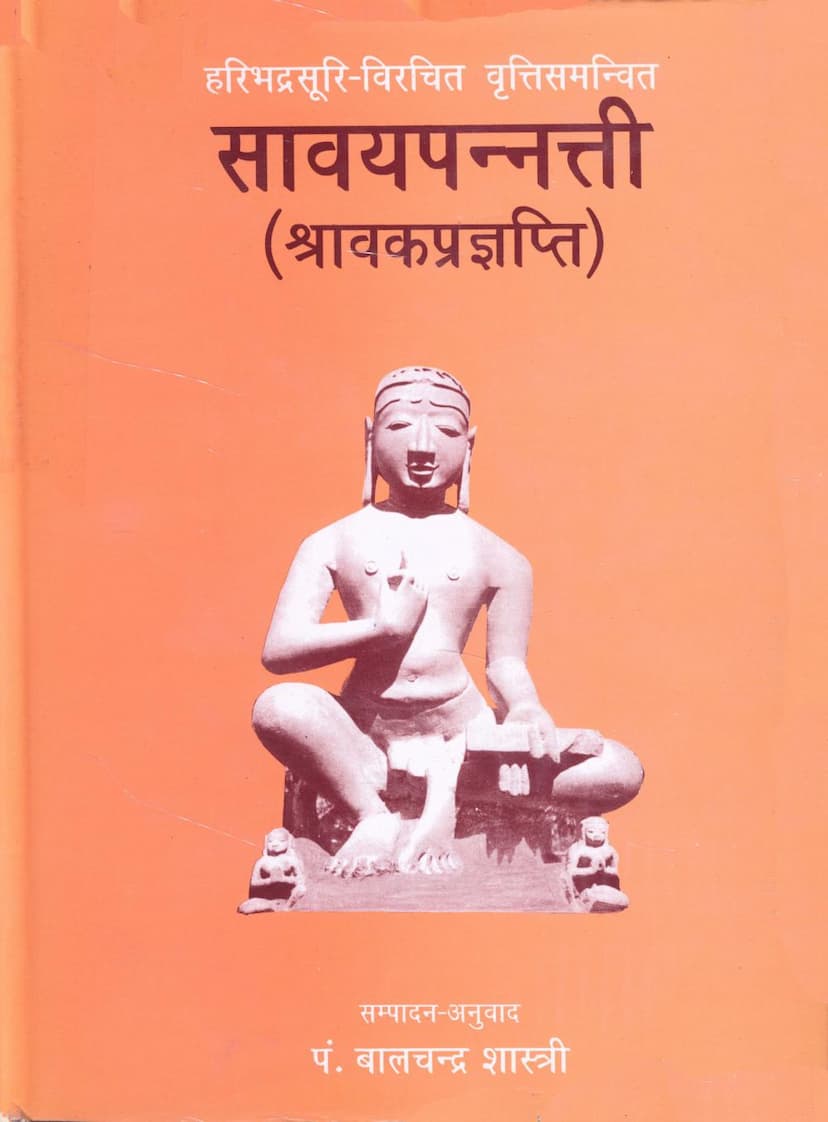Savay Pannatti
Added to library: September 2, 2025

Summary
The Jain text "Savay Pannatti" (also known as Śrāvakaprajñapti) is a significant work on Jain conduct and ethics, specifically for lay followers known as śrāvakas. Here's a summary based on the provided text:
Author and Context:
- Author: Acharya Haribhadrasuri, an influential Jain scholar of the 8th century CE.
- Basis: The text is composed in Prakrit in 401 Gāthās (verses) and is based on the seventh chapter of Acharya Umāsvāmi's (also known as Griddhpichchha) 'Tattvārthasūtra'.
- Publisher: Bharatiya Gyanpith, as part of the Moortidevi Granthamala series.
- Editors/Translators: Pt. Bal Chandra Shastri (Hindi translation and introduction).
Core Teachings and Structure:
"Savay Pannatti" is a foundational text for understanding the Śrāvaka Ācāra (conduct of a lay follower). The text defines a śrāvaka as someone who possesses right faith (samyaġdarśana) and listens to the proper conduct (samācārī) from monks and nuns.
The Śrāvaka Dharma is described as having twelve types:
- Five Anuvratas (Minor Vows): These are the core vows that form the foundation of lay life. They are:
- Ahiṁsā (Non-violence)
- Satya (Truthfulness)
- Acaurya (Non-stealing)
- Brahmacarya (Celibacy/Chastity)
- Aparigraha (Non-possession/Non-attachment) The text emphasizes that the primary focus is on sthūla (gross) violence, and the adherence to Ahiṁsā is paramount, leading to prohibitions on consuming root vegetables, etc., and certain fruits.
- Three Guṇavratas (Augmenting Vows): These vows enhance and support the Anuvratas. They are:
- Digvirati (Vow of limited direction)
- Upabhoga-paribhoga-parimāṇa-vrata (Vow of limited use and consumption)
- Anartha-danda-virati (Vow of abstaining from purposeless harm/actions)
- Four Śikṣāvratas (Training Vows): These are undertaken to progress towards the more rigorous vows and develop spiritual discipline. They are:
- Sāmāyika (Equanimity/Meditation at a fixed time)
- Dēśāvakāśika (Vow of limited spatial/temporal action)
- Pauṣadha-upavāsa (Fasting/observance on specific days)
- Ātithisaṁvibhāga (Charity/sharing with deserving individuals, often monks/nuns)
Key Themes and Concepts:
- Samyaġdarśana (Right Faith): This is considered the root of śrāvaka dharma. Without it, one cannot be a true śrāvaka. The text delves into the nature of samyaġdarśana, its causes, and its various classifications.
- Distinction between Lay and Monastic Life: The text aims to delineate the specific practices and limitations for lay followers, which are less stringent than those for monks (mahāvratas).
- Karma and Soul: The text discusses the relationship between the soul (jīva) and karma, outlining the eight types of karma, their durations, and how they influence the soul's journey.
- Distinction between Digambara and Śvetāmbara Traditions: The text notes differences in the order and classification of vows between the two major Jain traditions, suggesting that "Savay Pannatti" aligns more closely with Śvetāmbara Āgamas regarding the enumeration and order of vows like Digvirati and Upabhoga-paribhoga-parimāṇa.
- Detailed Analysis of Vows and Their Aticāras (Transgressions): A significant portion of the text elaborates on each vow, its benefits, and the potential transgressions (aticāras) that can weaken its observance.
- Daily Conduct and Practices: It touches upon the daily routine, ethical considerations in various activities, and the importance of supporting the monastic community.
- Speriority of Jain Ethics: The text highlights its importance in understanding the diverse ethical traditions within Jainism, noting its unique approach and style.
- Comparison with Other Texts: The preface extensively compares "Savay Pannatti" with other foundational Jain texts like Tattvārthasūtra, Upāsakadāśā, Sāgāradharmāmṛta, and others, noting similarities and differences, and establishing the authorship of Haribhadrasuri.
- Authorship Debate: While some manuscripts and commentaries attribute it to Umāsvāmi, the preface strongly argues for Haribhadrasuri as the author, citing stylistic differences, specific discussions on violence (e.g., regarding accidental vs. intentional harm), and the influence of Samantabhadra on Haribhadra. The use of first-person indicators in the commentary by Haribhadrasuri while referring to the original author, further suggests Haribhadra wrote the original text and its commentary.
Significance:
"Savay Pannatti" serves as a comprehensive guide for Jain laypeople, outlining their spiritual path, ethical duties, and the practices necessary for a virtuous life leading towards spiritual liberation. Its detailed classification of vows, explanations of aticāras, and philosophical underpinnings make it a valuable resource for both scholars and practitioners of Jainism.